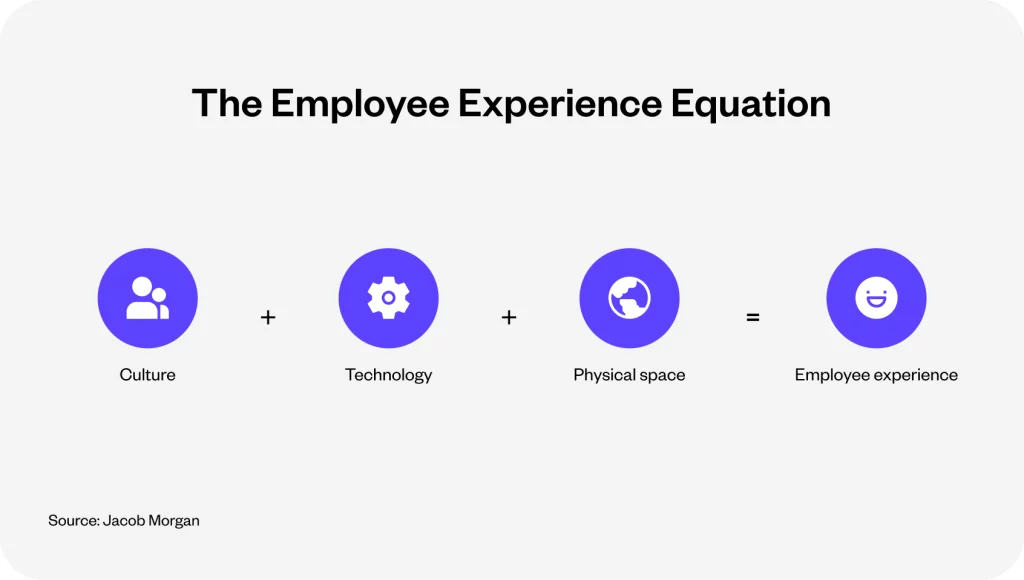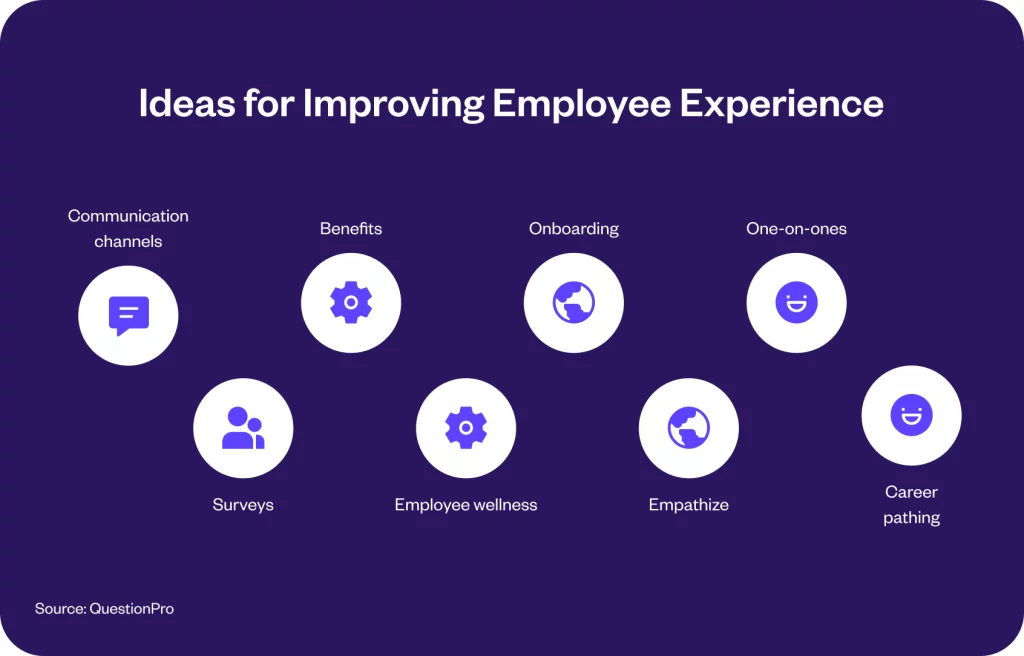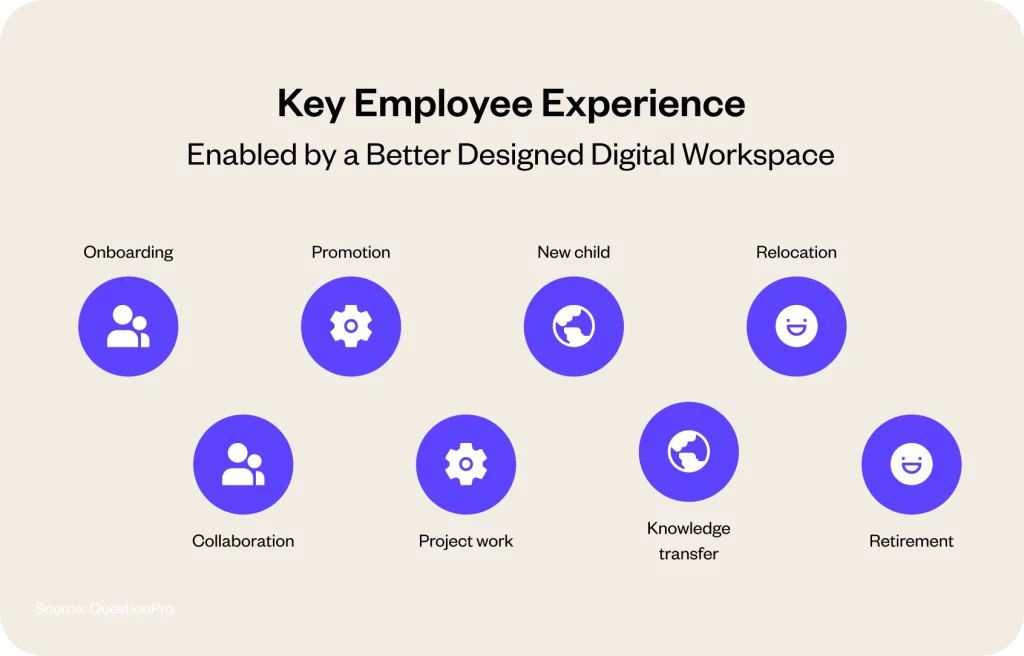Organizations with a definite employee experience (EX) strategy are 90% more likely to report lower annual employee turnover and higher productivity relative to their peers.
Workspaces world over have been forever altered with the advent of remote and hybrid work environments in the past few years. It’s reshaping the way we approach productivity, teamwork, and, most importantly, the employee experience. Gone are the days when employee satisfaction was limited to an ergonomic chair or a corner office. The digital employee experience has become a critical component of the overall employee journey, and it’s about so much more than convenience—it’s about creating a digital space where your employees feel valued, empowered, and inspired.
It’s no secret that a positive customer experience is the cornerstone of a successful business. However, achieving this requires a holistic approach that starts from within. By investing in the employee experience, you create an environment that fosters creativity, loyalty, and dedication. It’s an approach that values employees as the company’s most significant assets and treats their needs and experiences with the utmost importance.
Our guide delves deep into the innovative strategies and cutting-edge solutions that are shaping the employee experience landscape in 2023. Discover how you can provide them with an unparalleled digital experience that leads to higher engagement, satisfaction, and retention.
What is employee experience?
Employee experience (abbreviated to ‘EX’) refers to employees’ perceptions about their journey through every organizational touchpoint.
The EX journey begins when a candidate applies for a job to when they leave the company and everything in between. It includes the cultural experiences at the workplace, interaction with the management and co-workers and experiences with the workplace environment and technology. The company culture, physical workspace, people and technology are essential components of the employee experience.
The concept of employee experience emerged as a knockdown effect of a more familiar idea known as customer experience (CX). CX is one of the most effective means to understand customers and optimize their experience in B2C interactions. Just like CX covers the entire gamut of consumer experiences with a brand, EX covers employee experiences within an organization.
The importance of employee experience
As Jacob Morgan says, “Companies that invest in employee experience are 4x more profitable than those that do not.” However, profitability is just one way of looking at the employee experience advantage.
Creating a rewarding employee journey is more than a checkbox for the HR team because it has tangible impacts on business results and the overall organizational culture. The effects of a positive employee experience extend beyond what an employee learns and encounters within an organization.
Let’s look at some of the critical areas that employee experience affects.
1. Attract and retain top talent
A positive employee experience begins even before the first day on the job. Companies with a strong reputation for valuing their employees are more likely to attract top talent. Offering a supportive, inclusive, and engaging work environment can set an organization apart in the eyes of job-seekers. High-quality candidates often consider the overall EX when making employment decisions, so investing in a positive workplace experience can give companies a competitive edge in the battle for talent.
That’s not all, once in, employees today expect to be treated as unique individuals and look for meaningful, fulfilling jobs. When employees feel valued and included, they are more likely to stick around for the long haul, and contribute to your company’s success.
2. Enhance employee experience
Detached and demotivated employees are a liability to the company because they contribute to low productivity and high absentee rates. On the contrary, engaged employees are more productive, motivated, and invested in their work. By focusing on the employee experience, companies can foster a sense of belonging, connection, and purpose among their workforce. This leads to increased motivation, job satisfaction, and enthusiasm, ultimately driving higher levels of engagement.
3. Boost productivity and performance
A positive EX is closely linked to higher levels of productivity and performance. When employees feel valued, heard, and supported, they are more likely to contribute their best ideas, drive innovation, and go the extra mile for their team and organization. A well-designed employee experience can streamline processes, minimize workplace stress, and create an environment where employees can focus on their work without unnecessary distractions. Happy employees tend to work more efficiently, think creatively, and contribute to a culture of excellence.
4. Enhanced customer experience
Howard Schulz, CEO of Starbucks, said, “We built the Starbucks brand first with our people, not with the consumers.” Emphasizing the importance of employee experience in improving the customer journey, Schulz went on to say, “Because we believed that the best way to meet and exceed the expectations of our customers was to hire and train great people, we invested in employees.”
Happy employees equal happy customers and a single unhappy employee is enough to ruin the brand experience for several customers. Satisfied employees are more likely to create good vibes while interacting with customers. They are also more dedicated to understanding products and services, helping them serve customers better.
5. Business profitability
Happy employees are up to 20% more productive at the workplace.
Employee experience directly impacts the organization’s overall profitability. According to the IBM Smarter Workforce Institute, organizations scoring in the top 25% on employee experience report almost a 3x return on assets and a 2x return on sales. Employee experience is equally essential to directly link with organizational business outcomes, measured through return on assets (ROA) and return on sales (ROS). The higher the ROA and ROS, the better a company performs in terms of profitability and efficiency.
Factors that contribute to a positive employee experience
Jacob Morgan, author of ‘The Employee Experience Advantage,’ highlights culture, technology and physical workspace as the three basic components making up employee experience.
Three factors primarily shape the employee experience during their term at an organization: physical workspace, technology and workplace culture.

1. Physical workspace
The physical environment of a workplace includes everything from office furniture and lighting to facilities such as on-site gyms, recreation zones, coffee on tap and the like. In remote work culture, a physical workspace could also mean work-from-home setups or any workspace preferred by the employee. Employees who are satisfied with their work environment naturally concentrate better and are more productive.
2. Technology
Picture yourself in an office where every question requires manual intervention for clarification. It can be quite exhausting, right? Having to approach colleagues or HR personnel repeatedly to understand processes and services can consume valuable time. This is where an employee experience (EX) friendly technology steps in to make a difference.
Platforms like Yellow.ai with AI-powered self-service capabilities enable employees to find answers and resolve issues on their own. By reducing the need for manual intervention, Yellow.ai provides instant support, empowering employees to independently tackle problems and inquiries.
3. Workplace culture
Workplace culture is more than just a buzzword; it encompasses the collective attitudes, behaviors, and beliefs that shape the overall atmosphere in a work environment.
A positive workplace culture can be an uplifting and empowering force, driving employees to perform at their best and fostering a sense of belonging. Conversely, a toxic or negative workplace culture can suffocate and drain employees. It can result in a lack of trust, constant conflict, and a fear of making mistakes.
Nurturing a healthy culture that promotes respect, diversity, and inclusion will have a profound positive effect on employee satisfaction, retention, and overall success.
AI-powered EX automation

The 5 stages of employee experience
Now, you have a fundamental idea of what employee experience entails. Next, we’ll explore the key milestones in the employee lifecycle that contribute to the experiences employees gather during their tenure at an organization. We will also cover the role of employee surveys at each stage of the employee lifecycle.
Did you know, elevate day-to-day employee engagement and productivity with our Yellow.ai’s Conversational EX Cloud powered by generative AI.
1. Recruitment
The recruitment stage is critical to employee experience because it is an organization’s first chance to introduce its company culture to a potential employee. Regardless of whether a candidate joins your company, this stage is perfect for ensuring that they become an advocate for your organization.
An employee survey at this stage would typically involve getting feedback on the process and experience of applying to your organization. Ideally, survey questions should focus on the application process, interviews, interactions with interviewers and response time.
2. Onboarding
The onboarding stage is crucial to employee retention and an opportunity to integrate the new employee into the company culture. A smooth onboarding process helps new hires understand what a company expects of them and significantly impacts their tenure.
Following up onboarding with a new employee survey gives fresh ideas and insights since new hires are more likely to provide unbiased feedback. It also helps companies get valuable information about their hiring process and identify areas for improvement.
3. Development
The employee development stage begins when new recruits start working. At this stage, organizations must invest in nurturing employees’ skills and career development, show confidence and trust in employees, build clear communication channels and reward employees for their efforts.
Since employees’ career development is a significant investment for organizations, it makes sense to measure the efficacy of training programs. Surveys at this stage gauge the outcome of employee training, if employees find the new skills helpful, whether the skills improve productivity, etc.
4. Retention
Employee turnover is costly and thus, talent retention is a vital stage in the employee lifecycle model. The higher a company’s job satisfaction level, the lesser is its employee attrition rate – it can retain top talent within the organization. The key is to encourage open communication, listen with empathy and understand how you can help.
Employee retention surveys at this stage help employers discover employee perceptions within the organization. The survey findings, in turn, can help improve retention rates, drive employee engagement, decrease absenteeism, identify skill gaps and boost employee performance.
5. Exit
The last stage of the employee journey comes when an employee leaves the organization. No matter the reason for leaving, employee engagement is as crucial in the exit stage as it is in the recruitment stage.
Even when an employee is no longer a part of your workforce, their journey over the tenure is a window into the employee experience at your organization. Surveys at the exit stage offer an excellent window for employers to understand the employee’s reasons for leaving. It enables them to collect candid feedback on the overall employee experience.

Overcoming employee experience challenges in 2023
As we look ahead, the employee experience landscape is set to undergo significant transformations, bringing forth both fresh opportunities and challenges for workspaces. To this end, organizations must continuously adapt and stay proactive to create a positive and fulfilling employee experience.
Here are some potential focus areas that businesses might encounter while striving to enhance the employee experience:
- Adopting hybrid work models: Embrace hybrid work arrangements and find innovative ways to ensure seamless collaboration, promote work-life balance. Provide equitable experiences for all employees, regardless of their location.
- Prioritizing mental health and well-being: Be supportive of your employees’ mental health and well-being, implementing wellness programs, and fostering a culture that encourages open discussions about mental health.
- Cultivating a culture of inclusion: Diversity, equity, and inclusion initiatives will take center stage as organizations work to create a truly inclusive workplace where employees feel valued, respected, and able to bring their authentic selves to work.
- Upskilling and reskilling: As technology continues to advance, investing in employees’ skills development will be crucial. Organizations should focus on upskilling and reskilling initiatives to equip their workforce with the capabilities needed to thrive in a rapidly changing environment.
- Enhancing employee engagement: Explore creative approaches to boost employee engagement. Utilize technology, gamification, and feedback mechanisms to keep employees motivated and committed to their work.
- Remote team management: With remote work becoming a permanent fixture, managers must refine their leadership skills to effectively manage remote teams, build trust, and foster team cohesion.
- Embracing technology for efficiency: Leverage advanced HR technology and AI-driven tools to streamline processes, improve employee experiences, and provide personalized support to your workforce.
- Promoting career growth and mobility: Emphasize on career development opportunities, offering clear pathways for employees to grow within the organization and explore various roles.

Employee experience: Old rules vs. new rules
Changing demographics, unpredictable economic conditions and the explosion of social media are the key drivers of a redefined employee experience across organizations.
Corporates have entered a new era of employee experience with a workforce that thinks and acts differently from previous generations. Hence, it is high time for business leaders to revisit the rules that define employee experience and discard dated norms.
| Old rules | New rules |
| Annual engagement surveys define employee experience | Employee experience is an all-round perspective of life at work, defined through constant action, feedback and monitoring |
| Company culture is just a fancy term with no practical implications | Organizations use tools and metrics to define and measure culture through change and behavior |
| Rewards cover salary, bonus, overtime, benefits and other financial perks | Rewards also include non-financial perks such as leaves, vacations, meals and wellness programs |
| Compensation, rewards and benefits designed with a focus on impartiality | Balance between financial and non-financial compensation, rewards and benefits with the goal to improve quality of life |
| Health and wellness programs mainly focus on safety and insurance coverage | Integrating health and wellness programs including the employee, their family and the overall employee experience at work |
| Separate leaders across different HR services such as recruitment, training, engagement and so on | A chief employee experience officer or employee experience manager responsible for the entire employee journey at the organization |
| Employee self-service portals allow employees to access and request IT, HR, or facility-related services | Mobile employee experience platforms improve employer-employee communication while increasing employee engagement and productivity |
Importance of AI in improving EX and, in turn, CX
Organizations are increasingly using artificial intelligence (AI)-based solutions to improve employee experience and curate personalized, customer-centric approaches. These solutions are cost-effective and foster data-driven decision-making.
Let’s take a look at how deploying modern AI tools in different organizational areas improves the employee experience.
1. Recruitment – AI benefits both employers and candidates by making the recruitment process faster and more efficient. For instance, natural language processing (NLP) helps recruiters screen CVs and identify desirable traits while eliminating human bias. Conversational chatbots and application tracking systems leverage NLP and machine learning to help find the right candidates with ease.
2. Sentiment analysis – NLP can employ text analytics on feedback surveys and other communication to provide insights on employee sentiments within an organization. It aids in the identification of obstacles in the employee journey, allowing organizations to tailor their employee engagement strategies accordingly.
3. AI-enabled learning – Learning management systems (LMS) backed by AI can significantly reduce training time while helping employees learn more than they would in a traditional setting. AI-based LMS technology employs algorithms to predict the learner’s next steps and behavioral patterns to enable personalized learning.
4. Content analytics – It involves applying business intelligence and business analytics to figure out how users consume and engage with different types of digital content. AI-backed content analytics help organizations understand the resources employees use to do their job and focus on fine-tuning the knowledge assets with the greatest value.
5. Organizational network analysis (ONA) – AI and machine learning can help identify knowledge communities and networks within an organization. ONA facilitates visualizing how information, communications and decisions flow through an organization. When implemented throughout the organization, ONA impacts how employees connect and share ideas within groups.
How does Yellow.ai help businesses increase their employee engagement?
Recognizing the significance of a motivated and empowered workforce, Yellow.ai introduced Dynamic Automation Platform (DAP) powered by generative AI.
This innovative platform revolutionizes the way employees interact with their work environment, enhancing their engagement and overall experience.
By automating repetitive tasks, providing personalized support, and fostering continuous learning, Yellow.ai’s DAP paves the way for a more empowered and motivated workforce, unlocking their full potential and driving business growth.
Here are some notable features of Yellow.ai’s Dynamic Automation Platform:
- Streamlined workflows: DAP automates repetitive and mundane tasks, freeing up employees from manual, time-consuming processes. This enables employees to focus on more meaningful and challenging aspects of their work, boosting their job satisfaction and engagement.
- Personalized experiences: The generative AI technology used in DAP allows for more personalized interactions with employees. The platform can understand individual preferences, learning styles, and communication styles, creating a more tailored experience for each employee.
- Efficient knowledge sharing: DAP can serve as a knowledge repository, providing instant access to information and resources. Employees can quickly find answers to their questions and access relevant data, leading to increased productivity and a sense of empowerment.
- Continuous learning and development: Yellow.ai’s generative AI can offer personalized learning and development recommendations for each employee based on their strengths and areas for improvement. This fosters a culture of continuous learning and growth, which is highly motivating for employees.
Employee experience FAQ
What is employee experience?
Employee experience is an employee’s perceptions about their journey within an organization, from hiring and onboarding to the day they leave the organization.
What is good employee experience?
A good employee experience is where employees are valued and listened to and their needs are taken care of through consistent feedback and action.
Why is employee experience so important?
Employee experience is important to drive employee engagement and productivity, attract and retain talent and improve customer experience. All of these eventually result in increased business profitability.
How do you build employee experience?
Key strategies to create a positive employee experience include building a culture of transparency, investing in technology, offering growth opportunities, responding to feedback and improving engagem
What is the business impact of employee experience?
Creating an exceptional employee experience brings about far-reaching business advantages that extend beyond merely having a great workplace.
When employee experience is positive, their enthusiasm and dedication drive better business outcomes, ultimately leading to increased satisfaction among customers and investors.
Positive Employee Experience = High Employee Engagement = High Performance
Happy employees are up to 20% more productive at the workplace.
While the nuances of employee motivation have been studied for a long time now, putting a metric on their satisfaction levels has always been complex.
Traditionally, the employer-employee relationship has been seen as transactional, where employees exchange their services for a paycheck. However, in today’s world, employees are increasingly seeking more than just financial compensation.
A good way to encourage positive employee experience is by allowing them to speak their minds and promote active listening within your teams. When you do this, you not just make them feel heard but you’ll also be equipped to provide solutions or recommendations about certain processes and policies.
When employees are disengaged, it can cost the business between $450 billion to $550 billion per year.
Disengaged employees may be less productive, less committed to their tasks, and more likely to make mistakes, leading to decreased overall efficiency and effectiveness.
Thus, it is crucial for businesses to address employee engagement issues proactively to minimize costs and maintain a productive, thriving workforce.
How does employee experience affect customer experience?
The employee and customer experience are tightly knit.
According to recent research from Forbes and Salesforce, 70 percent agreed that a better employee experience leads directly to a better customer experience.
When a business truly values and takes care of its employees, providing them with motivation and empowerment, the employees respond by genuinely caring for the customers.
On the other hand, if a business fails to prioritize the well-being of its employees, the customers may find themselves dealing with disengaged and unhappy employees, leading to a negative overall experience they won’t forget.
Since CX directly reflects employee experience, business leaders need to act as a reflective mirror for everyone within the organization, encouraging them to see their strategies, roles, and actions from the perspective of customers.
Also, employees are more likely to support and adopt a CX strategy when they get a deeper understanding of how these strategies play a crucial part in shaping the overall customer experience. When employees can see the personal significance of their contributions, they become more motivated and engaged in delivering exceptional customer service.
How to design your employee experience strategy?
By embracing a people-first approach, you can create a workplace where employees are not just engaged but also fulfilled, motivated, and committed to achieving both their personal and organizational goals.
- To create an impactful employee experience strategy, start by getting to know your workforce personally. Understand their needs and aspirations, and set clear objectives for what you want to achieve.
- Walk in the shoes of your employees, map their journeys, and identify areas where they may need support or improvement. Empower them with opportunities for growth and learning, and consider offering flexible work options that fit their unique lives.
- Encourage strong bonds between managers and employees, fostering a sense of trust and mentorship. Leverage technology to streamline processes and enhance communication, making life easier for everyone.
- Continuously listen to employee feedback and use it to improve the strategy iteratively. Ensure your strategy is rooted in the organization’s core values, instilling a sense of purpose and belonging.
What are examples of employee experience?
A positive employee experience deals with a range of initiatives and practices aimed at fostering a supportive and fulfilling work environment. It begins with a well-structured onboarding process that welcomes new hires and sets clear expectations. Embracing flexible work arrangements, recognition programs, learning and development opportunities, and wellness initiatives shows a commitment to employee growth and well-being. Transparent communication, career growth prospects, and an inclusive workplace culture reinforce the organization’s dedication to employees’ success.
What is an employee experience platform?
An employee experience platform is a comprehensive software or digital tool designed to manage and optimize various aspects of the employee experience within an organization. It serves as a centralized hub where HR professionals, managers, and employees can access and interact with various tools, resources, and information related to their work environment and professional development. Yellow.ai is a great example for an employee experience platform. You can request for a quick demo right here.
What is the role of an employee experience specialist?
The role of an employee experience specialist is to focus on designing, implementing, and managing strategies and initiatives that enhance the overall employee experience within an organization. They play a critical role in ensuring that employees have a positive and fulfilling journey throughout their time with the company, from recruitment to departure.
They majorly focus on developing and implementing programs, policies, and practices that enhance the employee experience across various touchpoints, such as onboarding, learning and development, recognition, wellness, and performance management.
What are the benefits of employee experience platforms?
Employee experience platforms provide a centralized hub where all relevant tools, resources, and information are accessible to employees, HR professionals, and managers. This streamlines processes, reduces duplication of efforts, and enhances efficiency. They also offer personalized experiences based on individual preferences and needs. This personalized approach enhances employee satisfaction and increases the relevance of various resources and programs.
Conclusion
The concept of employee experience has evolved over the years to include a holistic view of an employee’s journey in an organization. With companies realizing that a positive employee experience leads to increased profitability and increased customer loyalty, enhancing the employee experience has become a priority.






















